3.4.3.1 Carbides
3.4.3.1.1 Silicon carbide
By far the most important carbide ceramics
are materials based on silicon carbide (SiC).
Diverse types are manufactured, depending on the intended
purpose, but all are characterised by the typical properties
of silicon carbide, such as
- very high hardness,
- corrosion resistance, even at high temperatures,
- high resistance to wear,
- high strength, even at high temperatures,
- resistance to oxidation even at very high temperatures,
- good thermal shock resistance,
- low thermal expansion,
- very high thermal conductivity,
- good tribological properties and
- semiconductivity.
The typical properties mentioned above are more or less pronounced
in the different varieties of the material. Depending on the
manufacturing technique, it is necessary to distinguish between
self-bonded and second-phase bonded silicon carbide ceramics,
as well as between open porous and dense types.
Open porous silicon carbide:
- silicate-bonded
silicon carbide
- recrystallized
silicon carbide (RSIC)
- nitride or oxynitride bonded
silicon carbide (NSIC)
|
Dense silicon carbide:
- reaction-bonded
silicon carbide (RBSIC)
- silicon-infiltrated
silicon carbide (SISIC)
- sintered silicon carbide (SSIC)
- hot [isostatic] pressed
silicon carbide (HPSIC, [HIPSIC])
- liquid-phase sintered
silicon carbide (LPSIC)
|
The type and proportion of the bonding are decisive in determining
the corresponding characteristic properties of the silicon
carbide ceramic.
Silicate bonded silicon carbide
is manufactured from coarse and medium grained SiC powders,
sintered with 5 to 15 % aluminosilicate binder in air. However,
strength, corrosion resistance, and above all the high-temperature
characteristics, are determined by the silicate binding matrix,
and lie below those of non-oxide bonded SiC ceramics. The
binding matrix begins to soften at very high application temperatures,
and the material begins to deform under stress. The advantage
lies in the comparatively low manufacturing cost. Applications
for this material include, for example, plate stackers used
in the manufacture of porcelain.
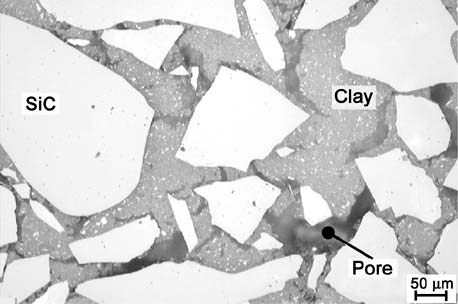
Figure 30: Microstructure of a coarse, silicate-bonded
silicon carbide
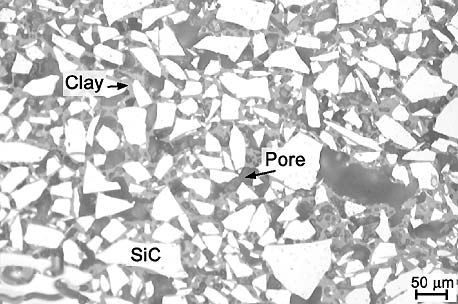
Figure 31: Microstructure of a fine-grained,
silicate-bonded silicon carbide
Liquid-phase sintered silicon carbide (LPSIC)
is a dense material containing SiC, a mixed oxynitride SiC
phase, and an oxide secondary phase. The material is manufactured
from silicon carbide powder and various mixtures of oxide
ceramic powders, often based on aluminium oxide. The oxide
components are responsible here for the density which, at
approx. 3.24 g/cm3, is somewhat higher than that of SSIC.
The components are compressed in a pressure sintering procedure
at a pressure of 20-30 MPa and a temperature of more than
2,000°C.
The material is also characterised by a fine-grained matrix
with grain sizes < 2 µm, by being almost entirely
free from pores, by very high strength and fracture toughness.
LPSIC lies somewhere between SSIC and the high strength and
toughness of Si3N4, from the point of view of mechanical properties,
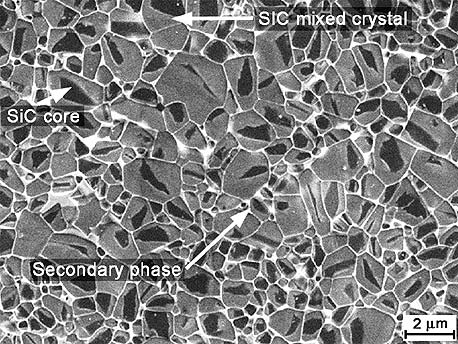
Figure 32: Microstructure of liquid-phase
sintered silicon carbide
Pressureless sintered silicon carbide (SSIC)
is produced using very fine SiC powder containing sintering
additives. It is processed using forming methods typical for
other ceramics and sintered at 2,000 to 2,200° C in an
inert gas atmosphere. As well as fine-grained versions, with
grain sizes < 5 ?m, coarse-grained versions with grain
sizes of up to 1.5 mm are available. SSIC is distinguished
by high strength that stays nearly constant up to very high
temperatures (approximately 1,600° C), maintaining that
strength over long periods!
This material displays an extremely high corrosion resistance
in acidic and basic media, and this too is maintained up to
very high temperatures. The coarse-grained versions offer
particular advantages. These properties are outstanding among
high-temperature ceramics, and are complemented by high thermal
shock resistance, high thermal conductivity, high resistance
to wear, and a hardness close to that of diamond. Thus, SSIC
is ideal for extremely demanding applications, for example,
slip ring seals in chemical pumps, bearing bushes, high temperature
burner nozzles, or as kiln furniture for very high application
temperatures. The use of SSIC with graphite inclusions improves
the performance of tribological systems.
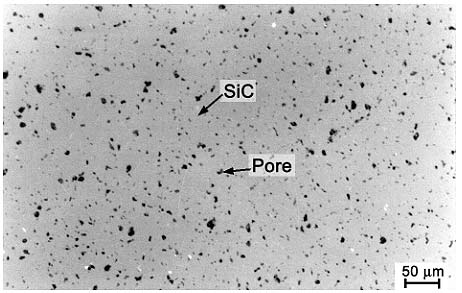
Figure 33: Microstructure of an SSIC (unetched)
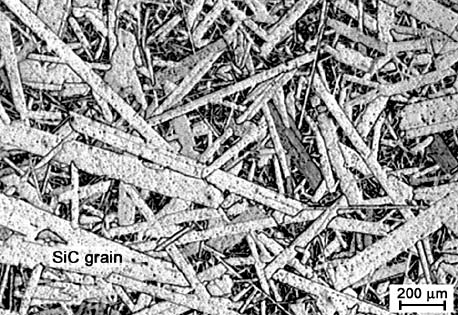
Figure 34: Microstructure of coarse-grained
SSIC (etched)
Hot-pressed silicon carbide (HPSIC)
and hot isostatic pressed silicon carbide (HIPSIC) exhibit
even better mechanical specifications compared to pressureless
sintered SSIC, since the products are nearly free of pores
due to the application of mechanical pressures reaching up
to about 2,000 bar. The axial (HP) and the isostatic (HIP)
pressing techniques limit the parts to be made to relatively
simple or small geometries, and involve greater expense compared
with pressureless sintering. As a result, HPSIC and HIPSIC
are used exclusively in the most demanding applications.
Reaction bonded silicon infiltrated
silicon carbide (SISIC)
is composed of approximately 85 to 94 % SiC and correspondingly
15 to 6 % metallic silicon (Si). SISIC has practically no
residual porosity.
This is achieved by infiltrating a formed part of silicon
carbide and carbon with metallic silicon. The reaction between
the liquid silicon and the carbon leads to SiC bonding between
SiC grains, and the remaining pore volume is filled with metallic
silicon. The advantage of this technique is that, in contrast
to powder sintering technologies, no shrinkage takes place
during the infiltration process. In this way unusually large
parts with very precise dimensions can be manufactured. The
application of SISIC is limited to approximately 1,380°
C due to the melting point of metallic silicon. Below this
temperature, SISIC exhibits very high strength and corrosion
resistance combined with good thermal shock resistance and
wear resistance. SISIC is thus ideal as a material for highly
stressed kiln furniture (beams, rolls, supports etc.) and
various burner parts for direct and indirect combustion (flame
tubes, recuperators and jet pipes).
It is also useful in machine construction for components that
must be highly resistant to wear and to corrosion (slip ring
seals).
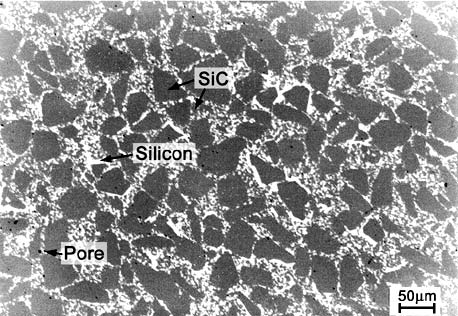
Figure 35: Microstructure of SISIC
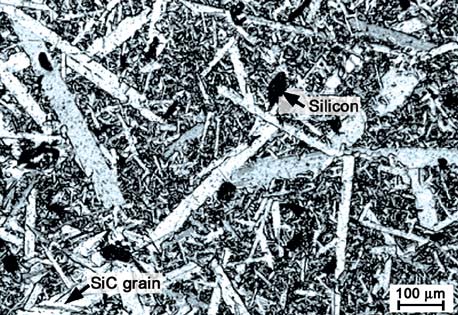
Figure 36: Microstructure of coarse-grained
SISIC
Recrystallized silicon carbide (RSIC)
is a pure silicon carbide material with approximately 11 to
15 % open porosity. This material is sintered at very high
temperatures from 2,300 to 2,500° C, at which a mixture
of extremely fine and coarse grains is converted to a compact
SiC matrix without shrinkage. As a result of its open porosity,
RSIC possesses lower strength in comparison to dense silicon
carbide ceramics.
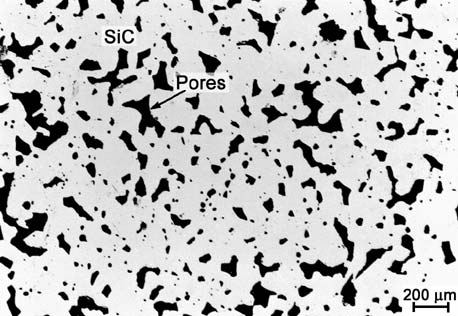
Figure 37: Microstructure of RSIC
Due to its porosity, RSIC demonstrates outstanding thermal
shock resistance. Analogous to SISIC, this shrinkage-free
sintering technique allows the manufacture of large parts
that are used primarily as heavy duty kiln furniture (beams,
rollers, supports etc.), for example in the porcelain industry.
Due to its open porosity, this material does not resist oxidation
over long periods, and is subject to a certain amount of corrosion
when applied as kiln furniture or as a heating element. The
maximum application temperature lies between 1,600 and 1,650°
C.
Nitride bonded silicon carbide
(NSIC)
is a porous material, having a porosity of between 10 and
15 %, of which between 1 and 5 % is opened porosity. The manufacturing
process is shrinkage-free, and involves a moulded body of
silicon carbide granulate and metallic silicon powder being
nitrided in an atmosphere of nitrogen at approx. 1,400 °C.
The initially metallic silicon changes here to silicon nitride,
creating a bond between the silicon carbide grains. The material
is then exposed to an oxidising atmosphere at a temperature
above 1,200 °C. In this way a thin oxidation layer of
glass is created.
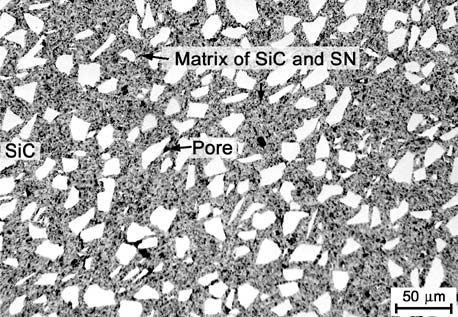
Figure 38: Microstructure of an NSIC
The effect of the matrix of silicon nitride is that workpieces
made from NSIC are only wetted with great difficulty by molten
non-ferrous metals.
The bending strength of NSIC his greater by approx. 100%,
because the pore size is smaller than that of RSIC. It is
also more resistant to oxidisation, while the tougher surface
means that it does not deform during its service life. This
material is particularly suitable for use in highly stressed
kiln furniture at up to 1,500°C.
3.4.3.1.2 Boron carbide
Boron carbide ceramics
(B4C) are manufactured, similarly to silicon
carbide ceramics, from sub-micron B4C powder in an inert gas
atmosphere at temperatures above 2,000° C without pressure
(SBC), hot pressed (HPBC), or hot isostatic pressed (HIPBC).
Boron carbide ceramics are distinguished by their outstanding
hardness, only exceeded by cubic boron nitrides and diamond.
The mechanical properties of boron carbide ceramics are similar
to those of silicon carbide, with the exception of comparatively
high wear resistance. The combination of very low density
(2.51 g/cm3), high mechanical strength and high elastic modulus
makes this type of ceramic particularly attractive in the
field of ballistic protection. Boron carbide ceramics can
only be used to a maximum of 1,000° C in oxidising atmospheres,
since it oxidises very rapidly at higher temperatures.
|
|
